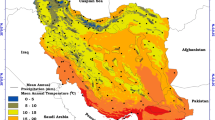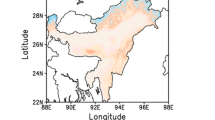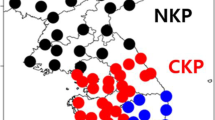Abstract
This study assesses the climate boundary shifts from the historical time to near/mid future by using a slightly modified Köppen–Geiger (KG) classification scheme and presents comprehensive pictures of historical (1960–1990) and projected near/mid future (1950s: 2040–2060/1970s: 2060–2080) climate classes across Nepal. Ensembles of three selected general circulation models (GCMs) under two Representative Concentration Pathways (RCP 4.5 and RCP 8.5) were used for projected future analysis. During the 1950s, annual average temperature is expected to increase by 2.5 °C under RCP 8.5. Similarly, during the 1970s, it is even anticipated to rise by 3.6 °C under RCP 8.5. The rate of temperature rise is higher in the non-monsoon period than in monsoon period. During the 1970s, annual precipitation is projected to increase by 8.1% under RCP 8.5. Even though the precipitation is anticipated to increase in the future in annual scale, winter seasons are estimated to be drier by more than 15%. This study shows significant increments of tropical (Am and Aw) and arid (BSk) climate types and reductions of temperate (Cwa and Cwb) and polar (ET and EF). Noticeably, the reduction of the areal coverage of polar frost (EF) is considerably high. In general, about 50% of the country’s area is covered by the temperate climate (Cwa and Cwb) in baseline scenario and it is expected to reduce to 45% under RCP 4.5 and 42.5% under RCP 8.5 during the 1950s, and 42% under RCP 4.5 and 39% under RCP 8.5 during the 1970s. Importantly, the degree of climate boundary shifts is quite higher under RCP 8.5 than RCP 4.5, and likewise, the degree is higher during the 1970s than the 1950s. We believe this study to facilitate the identification of regions in which impacts of climate change are notable for crop production, soil management, and disaster risk reduction, requiring a more detailed assessment of adaptation measures. The assessment of climate boundary shifting can serve as valuable information for stakeholders of many disciplines like water, climate, transport, energy, environment, disaster, development, agriculture, and tourism.










Similar content being viewed by others
Change history
01 November 2019
The original version of this article unfortunately contained an error. All “50s” and “70s” were replaced by “1950s” and “1970s” throughout the published paper.
References
Acharya, B. K., Cao, C., Xu, M., Khanal, L., Naeem, S., & Pandit, S. (2018). Present and future of dengue fever in Nepal: mapping climatic suitability by ecological niche model. International Journal of Environmental Research and Public Health, 1–15. https://doi.org/10.3390/ijerph15020187.
Aparecido LE de, O., Rolim G de, S., Richetti, J., de, S. P. S., & Johann, J. A. (2016). Köppen, Thornthwaite and Camargo climate classifications for climatic zoning in the State of Paraná, Brazil. Ciência e Agrotecnologia, 40(4), 405–417. https://doi.org/10.1590/1413-70542016404003916.
Aryal, A., Brunton, D., & Raubenheimer, D. (2014). Impact of climate change on human-wildlife-ecosystem interactions in the Trans-Himalaya region of Nepal. Theoretical and Applied Climatology, 115, 517–529. https://doi.org/10.1007/s00704-013-0902-4.
Baidya, S. K., Shrestha, M. L., & Sheikh, M. M. (2008). Trends in daily climatic extremes of temperature and precipitation in Nepal. Journal of Hydrology and Meteorology, 5(1), 38–51.
Basalirwa, C. P. K. (1995). Delineation of Uganda into climatological rainfall zones using the method of principal component analysis. International Journal of Climatology, 15(10), 1161–1177. https://doi.org/10.1002/joc.3370151008.
Beck, C., Grieser, J., Kottek, M., Rubel, F., & Rudolf, B. (2006). Characterizing global climate change by means of Koppen climate classification. In Annual Report. Duetscher Wetterdienst. Hamburg, Germany.
Beck, H. E., Zimmermann, N. E., Mcvicar, T. R., Vergopolan, N., Berg, A., & Wood, E. F. (2018). Data descriptor: Present and future Köppen-Geiger climate classification maps at 1 -km resolution. Scientific Data, 5, 1–12. https://doi.org/10.1038/sdata.2018.214.
Bharati, L., Gurung, P., Maharjan, L., & Bhattarai, U. (2016). Past and future variability in the hydrological regime of the Koshi Basin, Nepal. Hydrological Sciences Journal, 61(1), 79–93. https://doi.org/10.1080/02626667.2014.952639.
Bhatta, B., Shrestha, S., Shrestha, P. K., & Talchabhadel, R. (2019). Evaluation and application of a SWAT model to assess the climate change impact on the hydrology of the Himalayan River Basin. CATENA, 181(May), 104082. https://doi.org/10.1016/j.catena.2019.104082.
Bohlinger, P. (2018). A comprehensive view on trends in extreme precipitation in Nepal and their spatial distribution. International Journal of Climatology, 38, 1833–1845. https://doi.org/10.1002/joc.5299.
Dahal, V., Shakya, N. M., & Bhattarai, R. (2016). Estimating the impact of climate change on water availability in Bagmati Basin, Nepal. Environmental Processes, 3(1), 1–17. https://doi.org/10.1007/s40710-016-0127-5.
de Camargo, A. P. (1991). Classificação climática para zoneamento de aptidão agroclimática. Revista Brasileira de Agrometeorologia, 8, 126–131.
Dhimal, M., Hara, R. B. O., Karki, R., Thakur, G. D., Kuch, U., & Ahrens, B. (2014). Spatio-temporal distribution of malaria and its association with climatic factors and vector-control interventions in two high-risk districts of Nepal. Malaria Journal, 13, 1–14.
Feddema, J. J. (2005). A revised Thornthwaite-type global climate classification. Physical Geography, 26(6), 442–466. https://doi.org/10.2747/0272-3646.26.6.442.
Fick, S. E., & Hijmans, R. J. (2017). WorldClim 2: New 1-km spatial resolution climate surfaces for global land areas. International Journal of Climatology, 37, 4302–4315. https://doi.org/10.1002/joc.5086.
Flohn, H. (1950). Neue Anschauungen über die allgemeine zirkulation der atmosphareund ihre klimatische bedeutung. Erdkunde, 4, 141–162.
Fraedrich, K., Gerstengarbe, F. W., & Werner, P. C. (2001). Climate shifts during the last century. Climate Change, 50, 405–417.
Geiger, R. (1954). Klassifikation der klimate nach W. Köppen. In J. Bartels & P. Bruggencate (Eds.), Landolt- Börnstein – Zahlenwerte und Funktionen aus physik, chemie, astronomie (Geophysik und Technik, Alte Serie 3) (pp. 603–607).
Gnanadesikan, A., & Stouffer, R. J. (2006). Diagnosing atmosphere-ocean general circulation model errors relevant to the terrestrial biosphere using the Köppen climate classification. Geophysical Research Letters, 33, 1–5. https://doi.org/10.1029/2006GL028098.
Hijmans, R. J., Cameron, S. E., Parra, J. L., Jones, G., & Jarvis, A. (2005). Very high resolution interpolated climate surfaces for global land areas. International Journal of Climatology, 25, 1965–1978. https://doi.org/10.1002/joc.1276.
HMG. (1975). Mechidekhi Mahakali (I-IV Volumes). Department of Information, Ministry of Communication.
Holdridge, L. R. (1967). Life zone ecology. San Jose: Costa Rica, Tropical Science Center.
Jha, S., & Karn, A. (2001). Climatic analogues for the administrative districts of Nepal. Tribhuvan University Journal, 55–64.
Júnior, A. D. S., & De Carvalho, L. G. (2012). Application of the Köppen classification for climatic zoning in the state of Minas Gerais, Brazil. Theoretical and Applied Climatology, 108(1-2), 1–7. https://doi.org/10.1007/s00704-011-0507-8.
Jylhä, K., Tuomenvirta, H., Ruosteenoja, K., Niemi-Hugaerts, H., Keisu, K., & Karhu, J. A. (2010). Observed and projected future shifts of climatic zones in Europe and their use to visualize climate change information. Weather, Climate, and Society, 2(2), 148–167. https://doi.org/10.1175/2010wcas1010.1.
Kadel, I., Yamazaki, T., Iwasaki, T., & Abdillah, M. R. (2018). Projection of future monsoon precipitation over the central Himalayas by CMIP5 models under warming scenarios. Climate Research, 75, 1–21.
Kalvova, J., Halenka, T., Bezpalcova, K., & Nemesova, I. (2003). Köppen climate types in observed and simulated climates. Studia Geophysica et Geodaetica, 47, 185–202.
Karki, R., Talchabhadel, R., Aalto, J., & Baidya, S. K. (2016). New climatic classification of Nepal. Theoretical and Applied Climatology, 125(3–4), 799–808. https://doi.org/10.1007/s00704-015-1549-0.
Karki, R., Hasson, S., Schickhoff, U., & Scholten, T. (2017). Rising precipitation extremes across Nepal. Climate, 5(4), 1–25. https://doi.org/10.3390/cli5010004.
Köppen, W. (1884). Die Wärmezonen der Erde, nach der Dauer der heissen, gemässigten und kalten Zeit und nach der Wirkung der Wärme auf die organische Welt betrachtet (The thermal zones of the Earth according to the duration of hot, moderate and cold periods and of the impac). Meteorol. Z., 1, 215–226.
Köppen, W. (1900). Versuch einer Klassifikation der Klimate, Vorzugsweise nach ihren Beziehungen zur Pflanzenwelt [Attempted climate classification in relation to plant distributions]. Geographische Zeitschrift, 6, 593–611 657–679.
Köppen, W. (1918). Klassifikation der Klimate nach Temperatur, Niederschlag und Jahresablauf (Classification of climates according to temperature, precipitation and seasonal cycle). Petermanns Geogr. Mitt., 64, 193–203 243–248.
Köppen W. (1936). Das geographische System der Klimate. Handbuch der Klimatologie (c): 7–30. https://doi.org/10.3354/cr01204.
Kottek, M., Grieser, J., Beck, C., Rudolf, B., & Rubel, F. (2006). World map of the Köppen-Geiger climate classification updated. Meteorologische Zeitschrift, 15(3), 259–263. https://doi.org/10.1127/0941-2948/2006/0130.
Kriticos, D. J., Webber, B. L., Leriche, A., Ota, N., Macadam, I., Bathols, J., & Scott, J. K. (2012). CliMond: global high-resolution historical and future scenario climate surfaces for bioclimatic modelling. Methods in Ecology and Evolution, 3, 53–64. https://doi.org/10.1111/j.2041-210X.2011.00134.x.
Lohmann, U., Sausen, R., Bengtsson, L., Cubasch, U., Perlwitz, J., & Roecknerl, E. (1993). The Koppen climate classification as a diagnostic tool for general circulation models. Climate Research, 3, 177–193.
Mishra, Y., Nakamura, T., Babel, M. S., Ninsawat, S., & Ochi, S. (2018). Impact of climate change on water resources of the Bheri River Basin, Nepal. Water (Switzerland), 10(2), 1–21. https://doi.org/10.3390/w10020220.
Moss, R. H., Edmonds, J. A., Hibbard, K. A., Manning, M. R., Rose, S. K., Van Vuuren, D. P., Carter, T. R., Emori, S., Kainuma, M., Kram, T., Meehl, G. A., Mitchell, J. F. B., Nakicenovic, N., Riahi, K., Smith, S. J., Stouffer, R. J., Thomson, A. M., Weyant, J. P., & Wilbanks, T. J. (2010). The next generation of scenarios for climate change research and assessment. Nature, 463(7282), 747–756. https://doi.org/10.1038/nature08823.
Nayava, J. L. (1975). Climates of Nepal. The Himalayan Review VII, 9–12.
Pandey, V. P., Dhaubanjar, S., Bharati, L., & Thapa, B. R. (2019). Hydrological response of Chamelia watershed in Mahakali Basin to climate change. Science of the Total Environment. Elsevier B.V., 650, 365–383. https://doi.org/10.1016/j.scitotenv.2018.09.053.
Peel, M. C., Finlayson, B. L., & Mcmahon, T. A. (2007). Updated world map of the Köppen-Geiger climate classification. Hydrology and Earth System Sciences, 11, 1633–1644.
Russell, R. J. (1931). Dry climates of the United States: I climatic map. University of California, Publications in Geography, 5, 1–41.
Schickhoff, U., Bobrowski, M., Böhner, J., Bürzle, B., Chaudhary, R. P., Gerlitz, L., Heyken, H., Lange, J., Muller, M., Scholten, T., Schwab, N., & Wedegartner, R. (2015). Do Himalayan treelines respond to recent climate change? An evaluation of sensitivity indicators. Earth System Dynamics, 6, 245–265. https://doi.org/10.5194/esd-6-245-2015.
Shrestha, A. B., & Aryal, R. (2011). Climate change in Nepal and its impact on Himalayan glaciers. Regional Environmental Change, 11, 65–77. https://doi.org/10.1007/s10113-010-0174-9.
Shrestha, A. B., Wake, C. P., Mayewski, P. A., & Dibb, J. E. (1999). Maximum temperature trends in the Himalaya and its vicinity: An analysis based on temperature records from Nepal for the period 1971 – 94. Journal of Climate, 12, 2775–2786.
Shrestha, U. B., Gautam, S., & Bawa, K. S. (2012). Widespread climate change in the Himalayas and associated changes in local ecosystems. PLoS ONE, 7(5), 1–10. https://doi.org/10.1371/journal.pone.0036741.
Shrestha, S., Shrestha, M., & Babel, M. S. (2016). Modelling the potential impacts of climate change on hydrology and water resources in the Indrawati River Basin, Nepal. Environmental Earth Sciences, 75(4), 1–13. https://doi.org/10.1007/s12665-015-5150-8.
Stern, H., DeHoedt, G. (1999). Objective classification of Australian climates. 8th Conf. on Aviation, Range and Aerospace Meteorology. American Meteorological Society: Dallas, Texas, 87–91.
Talchabhadel, R., Karki, R., Thapa, B. R., Maharjan, M., & Parajuli, B. (2018a). Spatio-temporal variability of extreme precipitation in Nepal. International Journal of Climatology, 38, 4296–4313. https://doi.org/10.1002/joc.5669.
Talchabhadel, R., Nakagawa, H., & Kawaike, K. (2018b). Spatial and temporal variability of precipitation in southwestern Bangladesh. Journal of Japanese Society of Civil Engineers, Ser B1 (Hydraulic Engineering), 74(5), 289–294.
Talchabhadel, R., Karki, R., Yadav, M., Maharjan, M., Aryal, A., & Thapa, B. R. (2019). Spatial distribution of soil moisture index across Nepal: A step towards sharing climatic information for agricultural sector. Theoretical and Applied Climatology. https://doi.org/10.1007/s00704-019-02801-3.
Thapa, G. J., Wikramanayake, E., & Forrest, J. (2015). Climate-change impacts on the biodiversity of the Terai Arc Landscape and the Chitwan-Annapurna Landscape. Kathmandu.
Thornthwaite, C. W. (1948). An Approach toward a rational classification of climate. Geographical Review, 38(1), 55–94. https://doi.org/10.2307/210739.
Turner, A. G., & Annamalai, H. (2012). Climate change and the South Asian summer monsoon. Nature Climate Change, 2(8), 587–595. https://doi.org/10.1038/nclimate1495.
Uddin, K., Matin, M. A., & Maharjan, S. (2018). Assessment of land cover change and its impact on changes in soil erosion risk in Nepal. sustainability, 10, 1–20. https://doi.org/10.3390/su10124715.
Van Vuuren, D. P., Edmonds, J., Kainuma, M., Riahi, K., Nakicenovic, N., Smith, S. J., & Rose, S. K. (2011). The representative concentration pathways: An overview. Climate Change, 109, 5–31. https://doi.org/10.1007/s10584-011-0148-z.
Acknowledgements
The authors would like to thank the DHM, Government of Nepal, for the permission to use meteorological data.
Author information
Authors and Affiliations
Corresponding author
Ethics declarations
Conflict of interest
The authors declare that they have no conflict of interest.
Additional information
Publisher’s note
Springer Nature remains neutral with regard to jurisdictional claims in published maps and institutional affiliations.
Electronic supplementary material
ESM 1
(DOCX 92.1 kb)
Rights and permissions
About this article
Cite this article
Talchabhadel, R., Karki, R. Assessing climate boundary shifting under climate change scenarios across Nepal. Environ Monit Assess 191, 520 (2019). https://doi.org/10.1007/s10661-019-7644-4
Received:
Accepted:
Published:
DOI: https://doi.org/10.1007/s10661-019-7644-4




